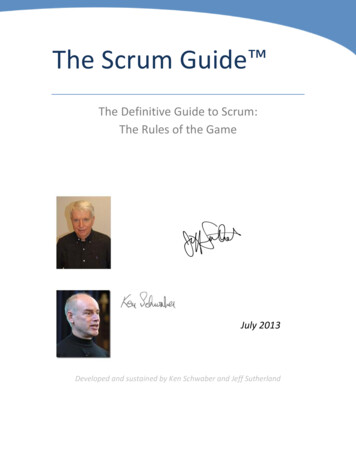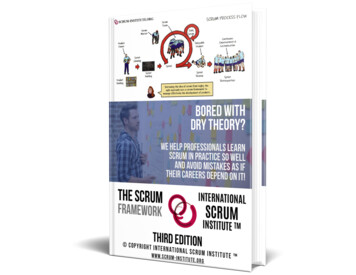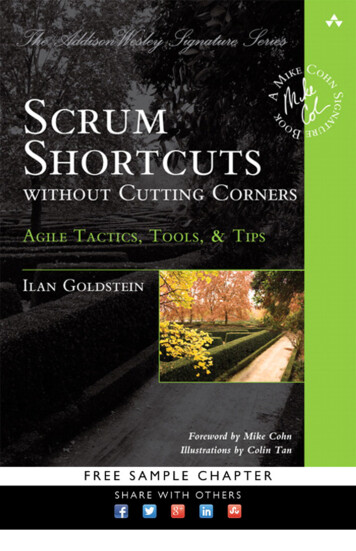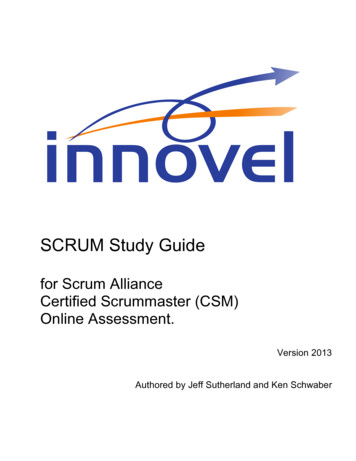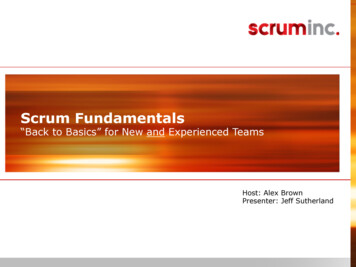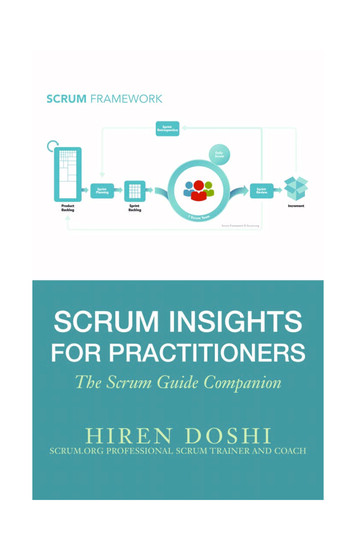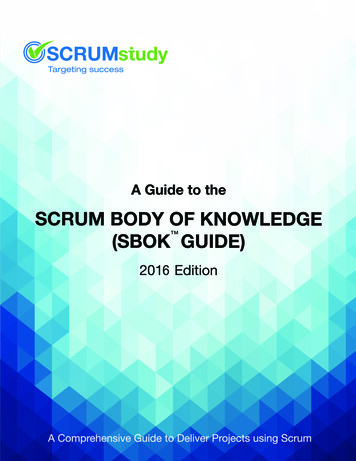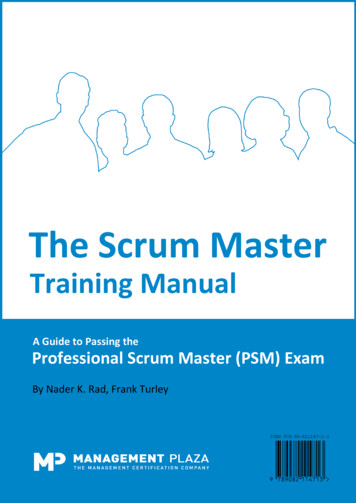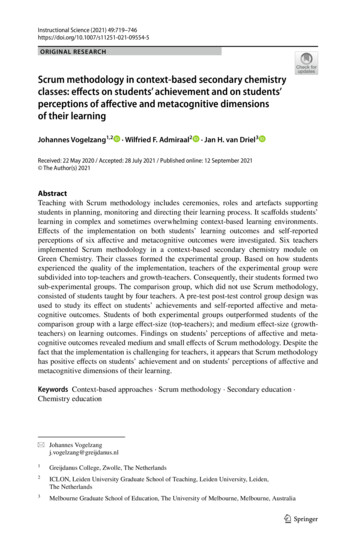
Transcription
Instructional Science (2021) 54-5ORIGINAL RESEARCHScrum methodology in context‑based secondary chemistryclasses: effects on students’ achievement and on students’perceptions of affective and metacognitive dimensionsof their learningJohannes Vogelzang1,2· Wilfried F. Admiraal2· Jan H. van Driel3Received: 22 May 2020 / Accepted: 28 July 2021 / Published online: 12 September 2021 The Author(s) 2021AbstractTeaching with Scrum methodology includes ceremonies, roles and artefacts supportingstudents in planning, monitoring and directing their learning process. It scaffolds students’learning in complex and sometimes overwhelming context-based learning environments.Effects of the implementation on both students’ learning outcomes and self-reportedperceptions of six affective and metacognitive outcomes were investigated. Six teachersimplemented Scrum methodology in a context-based secondary chemistry module onGreen Chemistry. Their classes formed the experimental group. Based on how studentsexperienced the quality of the implementation, teachers of the experimental group weresubdivided into top-teachers and growth-teachers. Consequently, their students formed twosub-experimental groups. The comparison group, which did not use Scrum methodology,consisted of students taught by four teachers. A pre-test post-test control group design wasused to study its effect on students’ achievements and self-reported affective and metacognitive outcomes. Students of both experimental groups outperformed students of thecomparison group with a large effect-size (top-teachers); and medium effect-size (growthteachers) on learning outcomes. Findings on students’ perceptions of affective and metacognitive outcomes revealed medium and small effects of Scrum methodology. Despite thefact that the implementation is challenging for teachers, it appears that Scrum methodologyhas positive effects on students’ achievement and on students’ perceptions of affective andmetacognitive dimensions of their learning.Keywords Context-based approaches · Scrum methodology · Secondary education ·Chemistry education* Johannes Vogelzangj.vogelzang@greijdanus.nl1Greijdanus College, Zwolle, The Netherlands2ICLON, Leiden University Graduate School of Teaching, Leiden University, Leiden,The Netherlands3Melbourne Graduate School of Education, The University of Melbourne, Melbourne, Australia13Vol.:(0123456789)
720J. Vogelzang et al.IntroductionContext-based learning approaches are developed and introduced to address severalchallenges in secondary chemistry education (Childs et al., 2015; Sevian et al., 2018).It has been suggested that students perceive the chemistry curriculum as fragmented,overloaded and as irrelevant for their personal lives (Gilbert, 2006). Moreover, transfer of chemistry concepts to new situations turns out to be difficult (Pilot & Bulte,2006). In general, a context-based approach starts with a relevant real-world question, stimulating students to use chemistry concepts to explore, experience and evaluate a problem extracted from real life (Taconis et al., 2016). Furthermore, educationalresearch revealed that context-based approaches, in general, have positive effects onboth students’ motivation, and their perception of relevance of chemistry for their personal lives (Bennett, 2017). Effects found on students’ achievements are ambiguous,with generally similar or slightly better results than more traditional approaches (Savelsbergh et al., 2016). However, students might experience context-based approachesas rather complex and overwhelming (King & Ritchie, 2012; Quintana et al., 2004).Although real-world questions are usually attractive and motivating for students,their complexity and open-endedness might evoke frustration and confusion. Moreover, the real-world question might conceal the underlying concepts (Parchmann et al.,2006), causing uncertainty among students about what to learn for their end-of-termexams. In addition, answering a complex and ill-structured real-world question setshigh demands on self-regulation processes, such as monitoring progress, and adjustinglearning strategies to optimize performance (Dori & Avargil, 2015; Panadero, 2017).Unfortunately, students do not always monitor and regulate these processes duringlearning with context-based approaches, which limits its potential and effectiveness aseducational method to enhance their learning (Azevedo et al., 2012).Therefore, implementing a scaffold to guide students through their learning processand to monitor their conceptual development might enhance students’ learning. Scaffolding makes complex tasks more manageable and accessible for students (HmeloSilver et al., 2007). An interesting approach would be to implement a project management framework in a context-based learning environment and explore whetherstudents experience a context-based approach as less complex. Project managementframeworks are used in business to guide employees working on complex projects. Inaddition, a project management framework consists of features to monitor the project’sprogress and to adjust to changing circumstances. It seems reasonable to expect thatthe implementation of a project management framework might be beneficial for students working on a rather complex real-world question. For that reason, we decided toimplement Scrum methodology as framework to scaffold students’ learning in contextbased learning environments. Scrum methodology provides ceremonies, roles and artefacts that invite students to reflect on their learning progress (Vogelzang et al., 2020b)and aims to scaffold students’ self-regulation processes (Pope-Ruark, 2012). As yet,Scrum methodology is seldom used in educational settings, although there are someexceptions (Cook, 2017; Parsons & MacCallum, 2019; Pope-Ruark, 2012). Therefore,insights in the effects of the implementation of Scrum methodology on students’ learning are still lacking. The current study aims to contribute to insights into effects of theuse of Scrum methodology on students’ learning in rather complex learning environments such as context-based chemistry education.13
Scrum methodology in context‑based secondary chemistry classes: 721Context‑based learningIn general, context-based approaches aim at various student outcomes, including cognitive,metacognitive and affective ones (Bennett, 2017; Dori & Avargil, 2015). First, contextbased approaches intend to promote students cognitive development and increase theirachievement by connecting a recognizable real-life issue to chemistry concepts. Instead oftransmitting knowledge to them by a teacher, students are invited to relate concepts (DePutter-Smits et al., 2013) and to construct meaningful knowledge structures themselves(Krajcik & Shin, 2014). These knowledge structures consist of interconnected conceptsrather than as isolated facts. Students construct and use these knowledge structures to interpret, analyze, and answer the real-world question (Hmelo-Silver, 2004). There is widespread consensus in the field of learning sciences that such student-centered approachescontribute to deep learning and sound understanding (Sawyer, 2014). Secondly, contextbased approaches require students to use and develop their metacognitive skills. Answeringan open real-world question demands skilled use of self-regulation processes, includingplanning, monitoring, reflection, and control of learning strategies (Azevedo et al., 2012;Dori & Avargil, 2015). Self-regulation of a learning process involves analysing the learningcontext, setting learning goals, determining learning strategies, reflecting whether the strategies are effective, and monitoring learning progress (Azevedo et al., 2012). Thirdly, context-based approaches intend to improve students’ attitude towards chemistry. This affective aim focuses on how students feel about the chemistry they do (Bennett, 2017). This isof utmost importance given the fact that in many countries students’ attitude towards chemistry is generally negative (Potvin & Hasni, 2014; Savelsbergh et al., 2016). By creating alearning environment in which students are rather autonomous in how they arrange theirwork, the hope is that this might engage students and influence their feelings of ownership(Katz & Assor, 2007). In addition, the context-based approach might contribute to a morerealistic picture of chemistry by showing how it is connected to their personal lives.The nature of context-based approaches matches constructivist learning principles.Therefore, context-based approaches share many similarities with student-centered learning environments, such as problem-based learning environments, in which students: (1)work collaboratively on real-world issues; (2) take ownership of their learning; (3) reflectexplicitly on their learning process and (4) use higher order thinking skills (Land et al.,2012). However, educational research revealed that students of all ages often perceive difficulties in such complex learning environments and students should be scaffolded to engagesuccessfully in student-centered learning environments (Azevedo et al., 2012). In a special issue on context-based approaches, Sevian et al., (2018, p. 4) emphasized there is aneed for studies with a focus on how students’ learning can be scaffolded. Moreover, theyrecommend to investigate the conditions that make learning in context-based classroomadvantageous. This study focuses on Scrum methodology as scaffold of students’ learningin context-based learning environments.Scrum methodologyScrum methodology is a project management framework, frequently used in businessand industry to manage and monitor complex projects (Schwaber & Sutherland, 2012). Itconsists of ceremonies, roles and artefacts that provide overview, induces feedback and13
722J. Vogelzang et al.dialogue systematically, and keeps employees on track to achieve the ultimate objectivesof the project. According to the developers there are three main principles that underlineScrum methodology: transparency, inspection and adaptation (Schwaber & Sutherland,2020). Scrum methodology aims to contribute to a social environment in which all participants take their responsibility and feel accountable to achieve the formulated objective.Moreover, they are actively involved in all phases of the entire project (transparency). Furthermore, participating employees are encouraged to provide feedback on the quality ofintermediate products (inspection). In addition, they are invited to propose improvementsto enhance the quality of both product and workflow during the project (adaptation). Thethree Scrum pillars are promoted by ceremonies, including the stand-up in which employees discuss perceived problems as well as how they will contribute to reach the commonobjective. In addition, all participating employees have a specific role in the team, including the role of a scrum master, who serves as a linking pin between Scrum team and customer. Furthermore, a scrum board, which can be seen as a graphical organizer, is usedas an artefact that reveals what employees have to do, where they are working on, andwhat has been done. In addition, employees are asked frequently to deliver an intermediateproduct. During these review ceremonies, the quality of the intermediate product will bediscussed with both customer and other employees. In this phase, employees and customerpropose improvements. The review ceremony is followed by the retrospective ceremony inwhich the participants discuss the quality of workflow in order to improve their workflow.Thus, Scrum methodology structures a social environment with clear procedures, rolesand artefacts. It creates moments of reflection and feedback systematically and visualizespotential challenges and problems in an early stage.Over time, Scrum methodology was adjusted for educational purposes (Cook, 2017;Parsons & MacCallum, 2019). Cook (2017) introduced Scrum methodology in a projectbased learning unit on climate change and found that her students showed initiative, wereself-directed and collaborated closely with their team mates. Furthermore, Parsons andMacCallum (2019) edited a book with experiences of the implementation of Scrum methodology in a variety of fields, including software development courses, mathematics andchemistry. In general, the experiences suggest that the use of Scrum methodology mightincrease metacognitive aspects of students’ learning, such as students’ planning skills andmutual collaboration. In addition, the experiences seem to suggest that cognitive learningoutcomes as well as affective aspects of students’ learning, such as attitude towards subject,are influenced positively. However, empirical research into the effects of the implementation of Scrum methodology on cognitive, metacognitive and affective aspects of students’learning is lacking.A concise overview of Scrum methodology including a short description in thirteensteps of how this approach can be adapted in a context-based learning environment, is presented in Table 1.As can be seen in Table 1, Scrum methodology aims at stimulating a classroom climate in which students work together, deploy and develop their personal qualities. Inaddition, their self-regulatory skills, their self-efficacy and their self-reflection, mightbe scaffolded by the different ceremonies, roles and artefacts of Scrum methodology.Moreover, its features have been connected to motivational scaffolds, including promoting autonomy, establishing task value and promoting emotion regulation, suggestingthat Scrum methodology might contribute to students’ learning and motivation (Vogelzang et al., 2019). Therefore, we might hypothesize that Scrum methodology providesa framework that scaffolds students’ ownership, stimulates discussion and reflection,and contributes to a learning environment in which students think more deeply about13
Team forming2Valuing itemsSprint planning56SprintStand-upSprint release89107Definition of doneDefinition of fun43Product ownerIntroduction1Scrum masterRolesStep CeremonyIntermediate productScrum boardProduct backlogArtefactsGroups of approximately four persons are formed based on personal qualities they want to develop or theywant to share with their team, such as taking leadership, perseverance or clear writing etc. Each teamhas a Scrum master, the first among equals. This student takes responsibility for the team’s progress andis the contact point for the product ownerThe product owner provides all teams with a product backlog, which consists of all learning goals, tasks,exercises and experiments necessary to answer the real-world questionBefore starting to work on all assignments, every group formulates its own definition of done (i.e.: ananswer to the question: “When are we satisfied with our achievement?”) and its own definition of fun:(i.e.: “How to create a learning environment in which we feel happy?”)Students discuss in their group the relative weight of all tasks and assignments. A small task is awarded 1point, a difficult task 5 points. This ceremony provides students with a clear picture of how many pointsthey have to ‘burn’ during a sprint (see step 8)All tasks and assignments are written on Post-Its, which are used to visualize students’ planning on theirScrum boardA Scrum board comprises three columns ‘to do’, ‘doing’ and ‘done’ and a ‘burndown chart’. It providesoverview of what tasks should be executed, are in progress or have been finished. The burndown chartshows how many points should be ‘burned’ during a lesson and reveals if students’ progress is satisfactoryAfter the planning phase, teams are ready to start their first sprint, which typically consists of a two-weekperiod, with approximately six lessons of 50 or 60 minAt the start of every lesson all team members gather around their Scrum board for a stand-up ceremony.They discuss (1) what they have done in the last lesson, (2) what they will contribute in the upcominglesson, and (3) if they experience any problemAt the end of a sprint, every team releases an intermediate product, which can have several forms, including a report, a graphic designThe teacher, as product owner, introduces the real-world question. Students are encouraged to ask questions about the objectives of the context-based approachDescriptionTable 1 Concise overview of the ceremonies, roles and artefacts of Scrum methodology, including how they are applied in a context-based learning environmentScrum methodology in context‑based secondary chemistry classes: 72313
13131211RolesArtefactsDescriptionFormative assessment During the review the quality of the intermediate product or students’ conceptual development is checked.An intermediate product, which, in general, has physical properties, is verified if it meets with the objectives. Students’ conceptual development is reviewed by using a formative assessment, which sheds lighton their understanding of concepts covered during the sprint and reveals misconceptions in an earlystageSprint retrospectiveTeams reflect on the learning strategies they used, assessing and discussing whether the strategies wereeffective in meeting the learning goals. In addition, they reflect on their motivational and affective stateand determine how much social support may be needed to perform a new sprint cycleSummative assessment or final productAfter finishing several sprint cycles, students deliver their final product in which they answer the realworld question. In addition, every student performs a summative assessment which focuses on theconcepts covered during the context-based approachSprint reviewStep CeremonyTable 1 (continued)724J. Vogelzang et al.
Scrum methodology in context‑based secondary chemistry classes: 725chemistry concepts, are more engaged with the subject of teaching and regulate theirlearning process more, compared to regular teaching.From a theoretical point of view it is clear that Scrum methodology scaffolds at leastthree challenges students face during their learning process: (1) sense making; (2) process management and (3) reflection (Quintana et al., 1999; Reiser, 2004). Sense makingrefers to the formulation of hypotheses and the interpretation of data to explain a scientific phenomenon. Process management skills are necessary to plan, to conduct experiments and to complete exercises. Reflection refers to monitoring and evaluating learningprogress as well as refining plans to proceed to the next step. During the sprints, students are working collaboratively on exercises and assignments to formulate hypotheses, to gather data and to interpret these data. Process management is scaffolded by thestand-up ceremony and with a scrum board. Such artefacts and ceremonies are expectedto help students to plan, direct and monitor their learning process. Finally, the reviewand retrospective ceremony aim to induce reflection upon both learning process and onunderstanding of subject matter knowledge.Purpose of the study and research questionsThis study can be seen as a response to a call to investigate conditions and circumstances that might enhance students’ learning in context-based approaches (Sevianet al., 2018). It explores whether Scrum methodology might be an appropriate scaffoldto direct students’ learning in context-based chemistry education. In the current study,effects of Scrum methodology were examined on students’ learning outcomes and theirself-reported affective and metacognitive skills.Two research questions guided this study:1. What is the effect of the use of Scrum methodology on students’ learning outcomes interms of understanding of relevant concepts? (RQ1)2. What is the effect of the use of Scrum methodology on students perceptions of affectiveand metacognitive aspects of their learning? (RQ2)MethodDesignA pre-test post-test quasi-experimental control group design was used to explore theimpact of the implementation of Scrum methodology on both students’ learning outcomes and their perceptions of affective and metacognitive aspects of their learning.As educational context a module on Green Chemistry was used (Jansen-Ligthelm et al.,2010). The experimental group included students whose teachers applied Scrum in theirclasses when teaching the Green Chemistry module, whereas teachers of the comparison group used their regular teaching styles.13
J. Vogelzang et al.726ParticipantsTen teachers of secondary schools all over the Netherlands implemented the Green Chemistry module in their classrooms as part of regular chemistry classes. Six of these teachers,from three schools with twelve different classes, used Scrum methodology as scaffold forstudents’ learning. Their students formed the experimental group. The other four teachers,from three schools and eight different classes, did not use Scrum methodology and theirstudents formed the comparison group (Table 2). All teachers graduated from universitywith a degree in chemistry as well as chemistry education. Nine teachers had taught chemistry for more than 15 years, whereas one teacher, participating in the experimental group,had 5 years of teaching experience.In total, 320 students (54%, grade 11) answered the questions of a pre-test and post-teston Green Chemistry. In addition, due to time constraints, only 256 students (43%) completed both the pre-test and post-test about their affective and metacognitive perceptions(Table 2).MaterialsA context-based approach was implemented in a module on Green Chemistry in secondary chemistry classrooms (Jansen-Ligthelm et al., 2010). Central theme in this module isthe need for new sustainable routes to produce innovative chemicals that do not harm theenvironment, are less hazardous and use renewable resources (Sjöström et al., 2015). Students become aware that Green Chemistry can be seen as the response of the chemical fieldto issues concerning our planet, (Lozano & Watson, 2013), that impacts people’s lives ingeneral and their personal lives in particular. During the module the twelve principles ofGreen Chemistry (Anastas & Warner, 1998) are presented (Table 3). For instance, studentscalculate the atom efficiency and reaction enthalpy of chemical reactions (resp. number 2and 6) and discuss the effect of a catalyst as well as the toxicity of reagents (resp. number9 and 10).The 12 principles of Green Chemistry converge during the final assignment of this module. Collaborative teams are invited to compare two different routes for the synthesis of adipic acid, an important precursor to produce nylon-6,6-polyamide. The facility to produceTable 2 Number of classes, teachers and schools as well as number participating studentsNN-students total/(N-female)N-students es (pre-test/post-test) aboutperceptionsPre-test/post-test withquestions on GreenChemistry190 (90)218 (103)66 (30)102 (57)256320Experimental group12 classes6 teachers3 schoolsComparison group8 classes4 teachers3 schoolsTotal13
Scrum methodology in context‑based secondary chemistry classes: 727Table 3 Green Chemistry principles1. Prevent wastes2. Efficient use of atoms3. Omit hazardous synthesis4. Products are degradable and benign5. Low risk and benign solvents6. Energy efficient design7. Practice with renewable feedstocks8. Limited number of reaction steps9. Auxiliary catalysts10. Non-toxic precursors and products11. Evaluation of process real time to prevent pollution12. To minimize safety risksadipic acid is located in their neighbourhood. Every team produces a written advice inwhich they substantiate what route is preferable considering the principles of Green Chemistry. Thus, students become aware that the synthesis of chemicals might affect their livingenvironment as well as their personal lives (see also Vogelzang et al. (2020a)). The writtenadvice task had the form of a report and was (virtually) addressed to local authorities toprovide them with relevant arguments to take a final decision on the greenest synthesis ofadipic acid. It can be characterised as a one-off task inspired on the work of Kolodner et al.(2003), who used similar tasks to stimulate students’ learning.Clearly, the structure of this context-based module fits within the theory of situatedlearning (Mandl & Kopp, 2005) and shares overlap with characteristics of problem-basedlearning (Hmelo-Silver, 2004). The central question is embedded in a real-life context, andthe assignments, tasks and labs are tailored to the subsequent stages of students’ learningprocess. Students work collaboratively on exercises that are gradually made more complex.Moreover, students are stimulated to plan and monitor their progress themselves. In addition, they are encouraged to critique and revise their work and invited to apply the chemistry concepts involved, to other situations.MeasuresStudents’ learning outcomesStudents’ learning outcomes were measured with the Green Chemistry concept test(GCCT, see Appendix 1). The GCCT was based on the concepts covered in the moduleon Green Chemistry (Jansen-Ligthelm et al., 2010) and consisted of twelve open questions, with scores varying from 1 to 3 points (maximum score 23 points). The questionsassessed students’ understanding of the principles of Green Chemistry (e.g.: E-factor,yield, atom-efficiency), as well as calculation of reaction energy using heats of formation.Content and face validity of the GCCT were checked by two secondary chemistry teachers,who were familiar with the module. The GCCT was piloted with 25 students, not participating in the present study. Answers of both the pilot and 25 students participating in thecurrent study, were scored independently by two teachers and resulted in an interrater reliability score, Cohen’s κ 0.98. Overall scores on pre-test as well as post-test were convertedin a percentage, ranging from 0 to 100%.Examples of questions: A manufacturer wants to produce a specific chemical. It turns out that there are twodifferent synthesis routes available. Method 1 has an atom efficiency of 50%, whereasmethod 2 has an atom efficiency of 75%. Explain which method is preferable (2 points).13
728J. Vogelzang et al. Methyl-tert-butylether (MBTE, C5H12O) is added to petrol to increase its anti-knockrating. MTBE is synthesized from methylpropene (C4H8) and methanol (CH3OH). Calculate the E-factor. Assume that the yield of the reaction is 100% (3 points).The quality of the written advices was not used as an outcome measure because we focusedon the learning outcomes of individual students. In another study, we analysed the quality of the advices with the SOLO-taxonomy. It turned out that groups in the experimentalcondition delivered more sophisticated advices then groups in the control condition (Vogelzang et al., 2020a).Affective and metacognitive aspects of students’ learningStudents completed a Likert-type Questionnaire with items on their perceptions of Affective and Metacognitive dimensions of their learning (QAM). The questionnaire was developed for this study. Several sources were used to develop appropriate items. QAM consisted of items on students’ attitude about chemistry, inspired by Bennett (2017), otheritems focused on students’ belief of their capabilities (Ajzen, 2002) to understand chemistry, and yet other items concentrated on whether the students perceived that they developedtheir personal qualities (Perry et al., 2019). Items concerning metacognitive dimensionsintended to measure how students experienced their mutual collaboration (Schraw et al.,2006), and their self-regulation (Panadero, 2017). In addition, QAM consists of itemsabout how students perceived the learning environment in general (Ambrose et al., 2010)and the guidance provided by the teacher in particular (Joseph, 2009). Face validity waschecked by two independent teachers, who suggested a few textual improvements. ThenQAM was piloted with one class (26 students), not participating in this study, to check ifstudents perceived any problem with regard to language clarity.A Principal Component Analysis (PCA) with Varimax rotation, using SPSS was executed on 34 items of the questionnaire of the entire dataset. Three additional questions,focusing on teachers’ behaviour, were excluded before executing the PCA, and formed anindependent scale. The Kaiser–Meyer–Okin tests revealed KMO-values of respectively0.929 and 0.941 for the pre-test and post-test. Six components had eigenvalues above theKaiser’s criterion of 1.0, explaining a total variance of 61.9% (pre-test) and 64.7% (posttest). These components were selected and fitted in two separate clusters, which could becharacterized as respectively an affective dimension and a metacognitive dimension of students’ learning (Bennett, 2017). All 34 items were included in the six components.Based on the item factor loadings the individual components were labelled as (1) selfefficacy (pre-test: 31.73%; post-test: 35.86%), (2) self-regulation (pre-test: 10.91%; posttest: 11.03%), (3) classroom climate (pre-test: 6.70%; post-test: 6.28%), (4) personal development (pre-test: 5.42%; post-test: 4.80%), (5) attitude towards chemistry (pre-test: 3.64%;post-test: 3.41%), (6) collaboration (pre-test: 3.48%; post-test: 3.33%). The six componentsfound during the Principal Component Analysis are presented in Table 4, including anexample item and the reliability in terms of Cronbach’s α. All analyses were performed inIBM SPSS Statistics version 25.ProceduresParticipating teachers and students gave their written consent to use their responses forresearch purposes. Students were informed that their responses were anonymised and13
Students’ feelings and beliefs about chemistry andtheir belief of their own capabilitiesAffective dimensionsAttitude towards chemistry Beliefs held about school chemistry contributing tostudents’ motivationClassroom climateA social, emotional, and in
advantageous. This study focuses on Scrum methodology as scaold of students’ learning in context-based learning environments. Scrum methodology Scrum methodology is a project management framework, frequently used in business and industry to manage and monit
